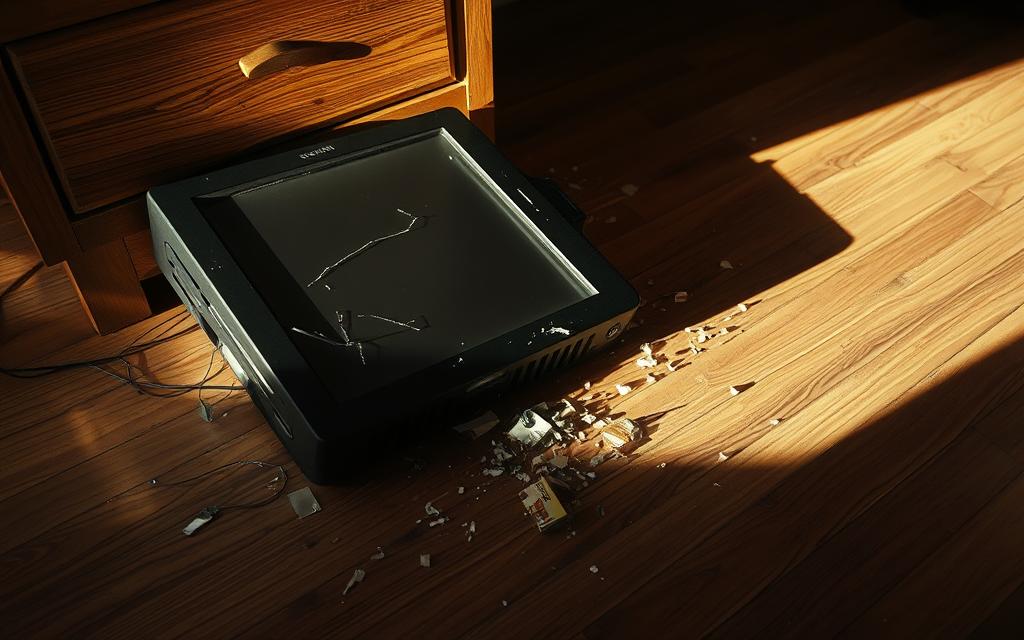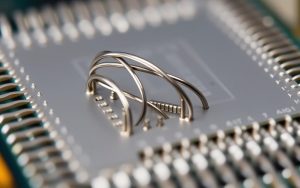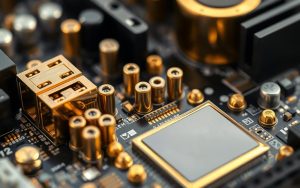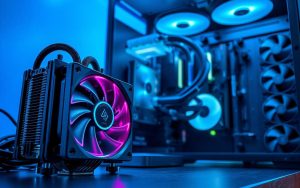Table of Contents
Accidents happen, especially with electronics placed on unstable surfaces. Every two weeks, a child in the U.S. gets hurt from furniture or TV tip-overs. This highlights the importance of securing devices properly.
Nightstands and dressers cause 40% of tip-over injuries, making them risky spots for delicate gadgets. Even short drops can damage internal parts, leading to costly repairs.
Assessing a dropped device quickly helps determine the next steps. Wall-mounting TVs or using anti-tip brackets provides stability—similar precautions work for computers.
The emotional stress of tech accidents adds to the frustration. Prevention and quick action reduce risks and keep devices running smoothly.
Immediate Steps to Assess the Damage
Drops can harm delicate electronics, even from short heights. Acting fast helps minimize risks and determine repair needs. Follow these steps to evaluate the condition thoroughly.
Inspect for Physical Damage
Examine the device for cracks, dents, or misaligned parts. Use a smartphone flashlight to spot hairline fractures. Pay special attention to hinges on laptops—loose mechanisms often signal internal issues.
Test Core Functions
Power on the device and check the display for distortions. Test USB ports with peripherals like mice or flash drives. If the screen remains black, connect an external monitor to rule out display failure.
Monitor Auditory Cues
Listen for unusual sounds: grinding fans or repetitive hard drive clicks indicate hardware stress. Normal operation involves steady whirring—abrupt noises warrant professional inspection.
| Component | Check Method | Red Flags |
|---|---|---|
| Screen | Display test patterns | Dead pixels, flickering |
| Battery | Power cycle | Rapid drainage, swelling |
| Storage | File access test | Corrupted data, slow response |
Pro Tip: Document all damage with photos for insurance claims. Temporary fixes like reseating RAM might restore functionality, but persistent issues require expert help.
Account for every component during inspection. Early detection prevents further deterioration and costly repairs.
Hidden Damage: Signs Your Computer Might Be Compromised
Not all damage from drops is visible at first glance. Internal components like thermal paste or hard drive mechanisms can shift, causing gradual failure. Watch for these subtle red flags.
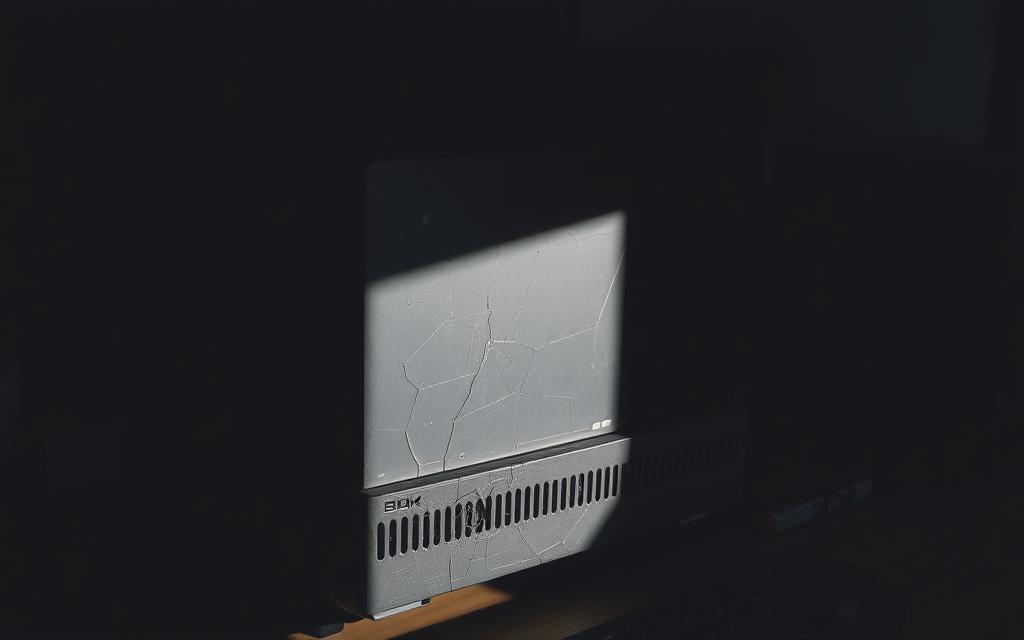
Performance Issues: Lag and Overheating
Sudden slowdowns or excessive heat suggest dislodged cooling elements. Thermal paste separation disrupts heat transfer, forcing fans to overwork. Compare temperatures to manufacturer benchmarks—consistently high readings demand attention.
Intermittent Crashes or Error Messages
Random shutdowns often stem from loose connections or failing storage. SSDs withstand drops better than HDDs due to no moving parts, but both can corrupt data. Frequent blue screens or freezing account for 30% of post-drop complaints.
How to Run Hardware Diagnostics
Built-in tools help identify issues:
- Windows Memory Diagnostic: Tests RAM for errors.
- Apple Diagnostics: Checks Mac hardware integrity.
- BIOS/UEFI tests: Reveals motherboard or CPU faults.
Angle of impact matters. Side drops harm screens, while flat falls damage internal mounts. Document symptoms to streamline repairs.
DIY Fixes for Minor Physical Damage
Simple fixes often restore dropped electronics to working condition. Before seeking professional help, try these solutions for common issues.
Reattaching Loose Components
Batteries and RAM modules may dislodge during impact. Power off the device and use an anti-static wristband to prevent static damage. Gently reseat components until they click into place.
Essential tools for safe repairs:
- Spudgers (plastic pry tools)
- Precision screwdrivers
- Torx bits (size varies by model)
Replacing Cracked Screens or Casings
Minor cracks might not affect functionality, but severe damage risks further harm. Compare costs:
| Repair Type | DIY Cost | Professional Cost |
|---|---|---|
| Laptop Screen | $50-$150 | $200-$400 |
| Plastic Casing | $20-$80 | $100-$250 |
Warning: Lithium batteries puncture easily. Avoid pressure near swollen cells.
Backing Up Data Preemptively
Always account for backup time after accidents. Choose between:
- Cloud backups (automatic, off-site)
- External drives (physical control)
Create a system image for full recovery. Use built-in tools like Windows Backup or Time Machine for Mac.
When to Seek Professional Repair Services
Professional assessment becomes crucial when DIY methods fail. Complex hardware issues, like logic board fractures or liquid damage, often need certified expertise. Delaying expert help risks permanent data loss or higher costs.
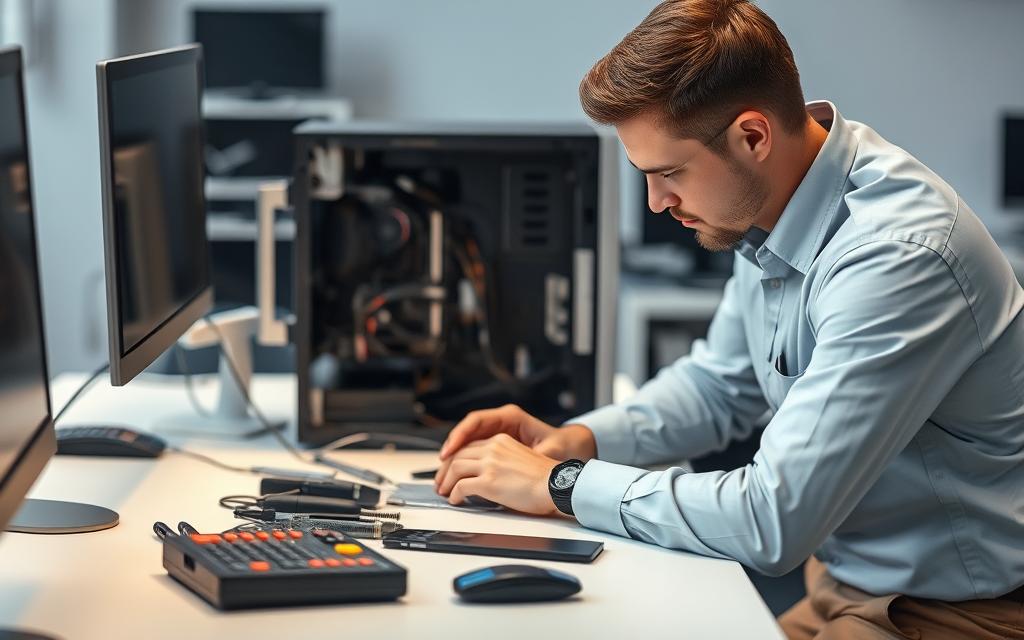
Cost-Benefit Analysis: Repair vs. Replacement
Compare repair expenses to device value. Older models may not justify costly fixes. Use this guide:
| Damage Type | Average Repair Cost | Replacement Threshold |
|---|---|---|
| Motherboard | $300–$800 | Devices >3 years old |
| Data Recovery | $200–$1,500 | Irreplaceable files only |
| Screen (4K Laptop) | $250–$600 | If >50% of new device cost |
Note: Soldering repairs (e.g., GPU reflow) are temporary fixes. Budget for eventual replacement.
Finding Certified Technicians
Trusted networks ensure quality:
- Apple Authorized Service Providers: Genuine parts, trained staff.
- Microsoft Certified Partners: Specialized for Surface devices.
- Micro-Accredited Repair Shops: Local options with verified skills.
Warranty and Insurance Considerations
Manufacturer warranties often void after unauthorized repairs. Third-party plans vary:
- Extended Warranties: Cover drops if purchased upfront.
- Renters/Home Insurance: May require police reports for claims.
Document damage with timestamps and receipts. Pro Tip: Backup data before surrendering devices for repairs.
Conclusion
Quick action determines whether a dropped device survives impact. Start with a damage assessment—check screens, ports, and sounds. Early detection cuts repair costs and prevents data loss.
Back up files immediately if the device powers on. Use cloud services or external drives. Delayed backups risk permanent file corruption.
Compare repair expenses to the device’s value. Minor fixes like reseating RAM cost little, but motherboard issues may justify replacement.
Prevent future accidents:
– Anchor cables with clips.
– Use anti-slip pads under electronics.
– Keep liquids away from workstations.
85% of professionally repaired devices regain full function. Document damage details for smoother claims.
FAQ
What should I do first if my laptop falls off a nightstand?
Inspect for visible damage like cracks or dents. Power it on to check basic functions such as the display, keyboard, and ports. Listen for unusual sounds like grinding or clicking.
How can I tell if there’s hidden internal damage?
Watch for performance drops, overheating, or frequent crashes. Run built-in diagnostics (like Windows Memory Diagnostic or Apple Diagnostics) to identify hardware failures.
Can I fix minor physical damage myself?
Yes, if components like the battery or RAM are loose, reseat them carefully. For cracked screens or severe casing damage, professional repair is recommended.
When should I take my device to a technician?
If diagnostics reveal critical errors, or if the cost of repair is lower than replacement. Always consult certified professionals, especially if under warranty.
Does homeowner’s or renter’s insurance cover accidental drops?
Some policies include electronics protection. Check your coverage details and file a claim if applicable. Manufacturer warranties often exclude accidental damage.
How do I back up data if the device is unstable?
Use cloud storage or an external drive immediately. If the system boots, enable automatic backups. For non-functional devices, a repair shop may recover data.


